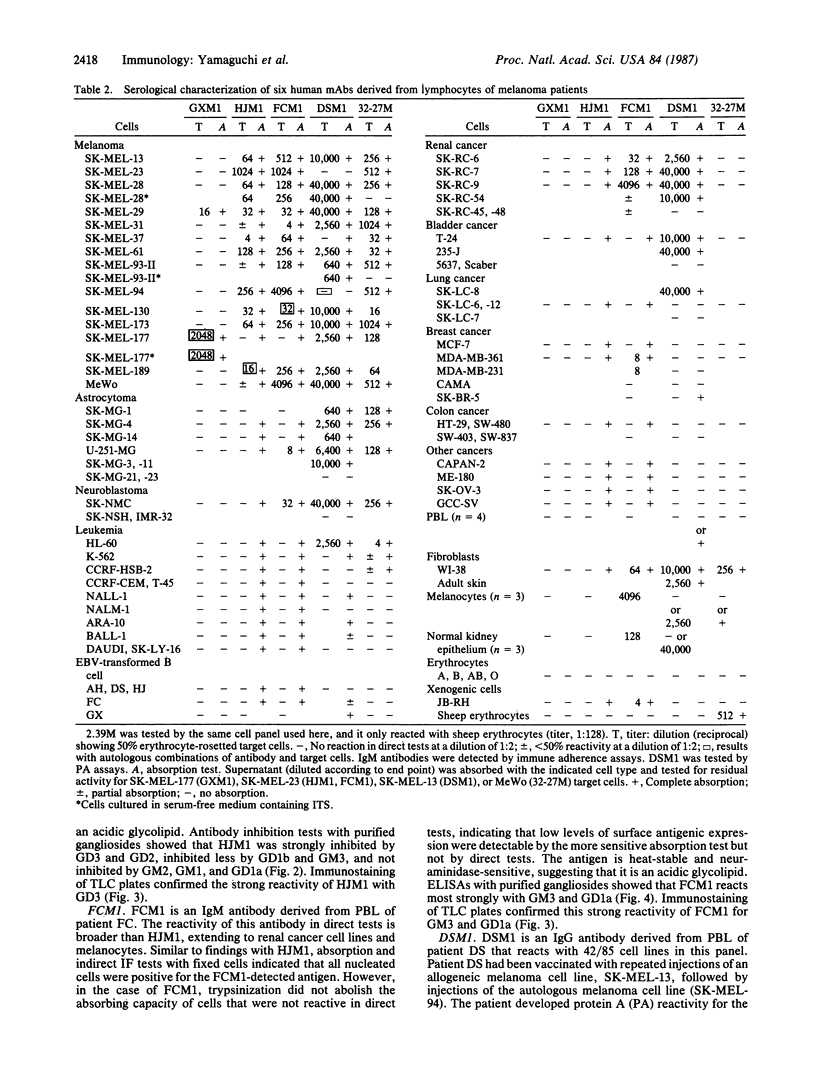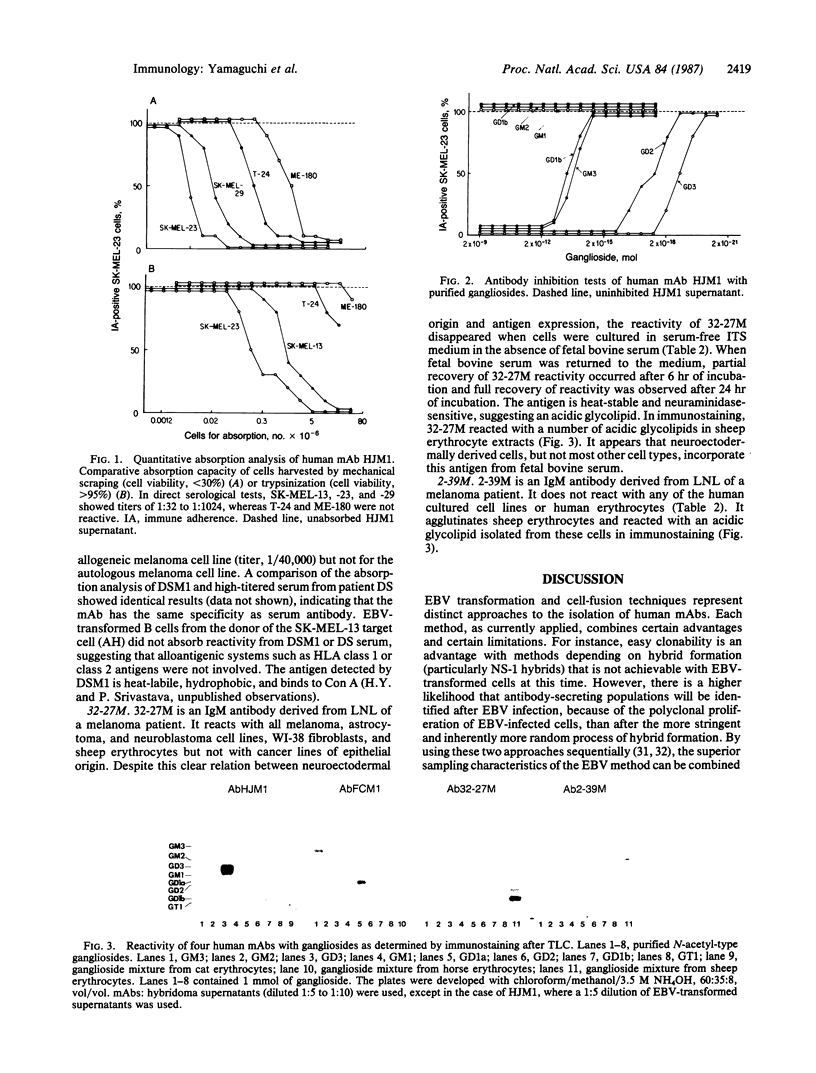Abstract
Human monoclonal antibodies (mAbs) were derived from lymph node lymphocytes and peripheral blood lymphocytes (PBL) from patients with melanoma. Four methods for generating human mAbs were compared: fusion with human [LICR-LON-HMy-2 (LICR-2)] or mouse (NS-1) cells; transformation by Epstein-Barr virus (EBV); and EBV transformation followed by NS-1 fusion. NS-1 fusion with lymph node lymphocytes resulted in a higher number of growing hybrids than LICR-2 fusion. Virtually no hybrids were obtained from NS-1 or LICR-2 fusions with PBL. EBV transformed lymphocytes from lymph node and peripheral blood with equal efficiency, and the yield of proliferating cultures for antibody screening was more than 10- to 30-fold greater than that obtained by fusion techniques. However, once antibody-producing cultures had been identified, stability and clonability of EBV-transformed cells were poorer than that of NS-1 hybrid cells. To combine the strengths of both methods, cultures of EBV-transformed cells were fused with NS-1; and hybrid clones were isolated that showed vigorous growth, clonability, and stable antibody secretion. Detailed specificity analysis of the mAbs produced by six of these clones indicated detection of a class 1 (unique) melanoma antigen, a class 3 melanoma antigen, and four ganglioside antigens (GD3, GM3, and two other, as yet uncharacterized, heterophile antigens).
Full text
PDF




Images in this article
Selected References
These references are in PubMed. This may not be the complete list of references from this article.
- Albino A. P., Lloyd K. O., Houghton A. N., Oettgen H. F., Old L. J. Heterogeneity in surface antigen and glycoprotein expression of cell lines derived from different melanoma metastases of the same patient. Implications for the study of tumor antigens. J Exp Med. 1981 Dec 1;154(6):1764–1778. doi: 10.1084/jem.154.6.1764. [DOI] [PMC free article] [PubMed] [Google Scholar]
- Anichini A., Fossati G., Parmiani G. Clonal analysis of cytotoxic T-lymphocyte response to autologous human metastatic melanoma. Int J Cancer. 1985 May 15;35(5):683–689. doi: 10.1002/ijc.2910350518. [DOI] [PubMed] [Google Scholar]
- Bystryn J. C., Jacobsen S., Harris M., Roses D., Speyer J., Levin M. Preparation and characterization of a polyvalent human melanoma antigen vaccine. J Biol Response Mod. 1986 Jun;5(3):211–224. [PubMed] [Google Scholar]
- Cahan L. D., Irie R. F., Singh R., Cassidenti A., Paulson J. C. Identification of a human neuroectodermal tumor antigen (OFA-I-2) as ganglioside GD2. Proc Natl Acad Sci U S A. 1982 Dec;79(24):7629–7633. doi: 10.1073/pnas.79.24.7629. [DOI] [PMC free article] [PubMed] [Google Scholar]
- Carey T. E., Lloyd K. O., Takahashi T., Travassos L. R., Old L. J. AU cell-surface antigen of human malignant melanoma: solubilization and partial characterization. Proc Natl Acad Sci U S A. 1979 Jun;76(6):2898–2902. doi: 10.1073/pnas.76.6.2898. [DOI] [PMC free article] [PubMed] [Google Scholar]
- Carey T. E., Takahashi T., Resnick L. A., Oettgen H. F., Old L. J. Cell surface antigens of human malignant melanoma: mixed hemadsorption assays for humoral immunity to cultured autologous melanoma cells. Proc Natl Acad Sci U S A. 1976 Sep;73(9):3278–3282. doi: 10.1073/pnas.73.9.3278. [DOI] [PMC free article] [PubMed] [Google Scholar]
- Cote R. J., Morrissey D. M., Houghton A. N., Beattie E. J., Jr, Oettgen H. F., Old L. J. Generation of human monoclonal antibodies reactive with cellular antigens. Proc Natl Acad Sci U S A. 1983 Apr;80(7):2026–2030. doi: 10.1073/pnas.80.7.2026. [DOI] [PMC free article] [PubMed] [Google Scholar]
- Dippold W. G., Lloyd K. O., Li L. T., Ikeda H., Oettgen H. F., Old L. J. Cell surface antigens of human malignant melanoma: definition of six antigenic systems with mouse monoclonal antibodies. Proc Natl Acad Sci U S A. 1980 Oct;77(10):6114–6118. doi: 10.1073/pnas.77.10.6114. [DOI] [PMC free article] [PubMed] [Google Scholar]
- Furukawa K., Clausen H., Hakomori S., Sakamoto J., Look K., Lundblad A., Mattes M. J., Lloyd K. O. Analysis of the specificity of five murine anti-blood group A monoclonal antibodies, including one that identifies type 3 and type 4 A determinants. Biochemistry. 1985 Dec 17;24(26):7820–7826. doi: 10.1021/bi00347a047. [DOI] [PubMed] [Google Scholar]
- Houghton A. N., Brooks H., Cote R. J., Taormina M. C., Oettgen H. F., Old L. J. Detection of cell surface and intracellular antigens by human monoclonal antibodies. Hybrid cell lines derived from lymphocytes of patients with malignant melanoma. J Exp Med. 1983 Jul 1;158(1):53–65. doi: 10.1084/jem.158.1.53. [DOI] [PMC free article] [PubMed] [Google Scholar]
- Houghton A. N., Mintzer D., Cordon-Cardo C., Welt S., Fliegel B., Vadhan S., Carswell E., Melamed M. R., Oettgen H. F., Old L. J. Mouse monoclonal IgG3 antibody detecting GD3 ganglioside: a phase I trial in patients with malignant melanoma. Proc Natl Acad Sci U S A. 1985 Feb;82(4):1242–1246. doi: 10.1073/pnas.82.4.1242. [DOI] [PMC free article] [PubMed] [Google Scholar]
- Irie R. F., Irie K., Morton D. L. A membrane antigen common to human cancer and fetal brain tissues. Cancer Res. 1976 Sep;36(9 Pt 2):3510–3517. [PubMed] [Google Scholar]
- Irie R. F., Sze L. L., Saxton R. E. Human antibody to OFA-I, a tumor antigen, produced in vitro by Epstein-Barr virus-transformed human B-lymphoid cell lines. Proc Natl Acad Sci U S A. 1982 Sep;79(18):5666–5670. doi: 10.1073/pnas.79.18.5666. [DOI] [PMC free article] [PubMed] [Google Scholar]
- Kan-Mitchell J., Imam A., Kempf R. A., Taylor C. R., Mitchell M. S. Human monoclonal antibodies directed against melanoma tumor-associated antigens. Cancer Res. 1986 May;46(5):2490–2496. [PubMed] [Google Scholar]
- Knuth A., Danowski B., Oettgen H. F., Old L. J. T-cell-mediated cytotoxicity against autologous malignant melanoma: analysis with interleukin 2-dependent T-cell cultures. Proc Natl Acad Sci U S A. 1984 Jun;81(11):3511–3515. doi: 10.1073/pnas.81.11.3511. [DOI] [PMC free article] [PubMed] [Google Scholar]
- Kozbor D., Roder J. C., Chang T. H., Steplewski Z., Koprowski H. Human anti-tetanus toxoid monoclonal antibody secreted by EBV-transformed human B cells fused with murine myeloma. Hybridoma. 1982;1(3):323–328. doi: 10.1089/hyb.1.1982.1.323. [DOI] [PubMed] [Google Scholar]
- Livingston P. O., Shiku H., Bean M. A., Pinsky C. M., Oettgen H. F., Old L. J. Cell-mediated cytotoxicity for cultured autologous melanoma cells. Int J Cancer. 1979 Jul 15;24(1):34–44. doi: 10.1002/ijc.2910240107. [DOI] [PubMed] [Google Scholar]
- Miller G., Lipman M. Release of infectious Epstein-Barr virus by transformed marmoset leukocytes. Proc Natl Acad Sci U S A. 1973 Jan;70(1):190–194. doi: 10.1073/pnas.70.1.190. [DOI] [PMC free article] [PubMed] [Google Scholar]
- Mukherji B., MacAlister T. J. Clonal analysis of cytotoxic T cell response against human melanoma. J Exp Med. 1983 Jul 1;158(1):240–245. doi: 10.1084/jem.158.1.240. [DOI] [PMC free article] [PubMed] [Google Scholar]
- Natoli E. J., Jr, Livingston P. O., Pukel C. S., Lloyd K. O., Wiegandt H., Szalay J., Oettgen H. F., Old L. J. A murine monoclonal antibody detecting N-acetyl- and N-glycolyl-GM2: characterization of cell surface reactivity. Cancer Res. 1986 Aug;46(8):4116–4120. [PubMed] [Google Scholar]
- Old L. J. Cancer immunology: the search for specificity--G. H. A. Clowes Memorial lecture. Cancer Res. 1981 Feb;41(2):361–375. [PubMed] [Google Scholar]
- Pukel C. S., Lloyd K. O., Travassos L. R., Dippold W. G., Oettgen H. F., Old L. J. GD3, a prominent ganglioside of human melanoma. Detection and characterisation by mouse monoclonal antibody. J Exp Med. 1982 Apr 1;155(4):1133–1147. doi: 10.1084/jem.155.4.1133. [DOI] [PMC free article] [PubMed] [Google Scholar]
- Real F. X., Mattes M. J., Houghton A. N., Oettgen H. F., Lloyd K. O., Old L. J. Class 1 (unique) tumor antigens of human melanoma. Identification of a 90,000 dalton cell surface glycoprotein by autologous antibody. J Exp Med. 1984 Oct 1;160(4):1219–1233. doi: 10.1084/jem.160.4.1219. [DOI] [PMC free article] [PubMed] [Google Scholar]
- Shiku H., Takahashi T., Oettgen H. F. Cell surface antigens of human malignant melanoma. II. Serological typing with immune adherence assays and definition of two new surface antigens. J Exp Med. 1976 Oct 1;144(4):873–881. doi: 10.1084/jem.144.4.873. [DOI] [PMC free article] [PubMed] [Google Scholar]
- Steinitz M., Klein G., Koskimies S., Makel O. EB virus-induced B lymphocyte cell lines producing specific antibody. Nature. 1977 Sep 29;269(5627):420–422. doi: 10.1038/269420a0. [DOI] [PubMed] [Google Scholar]
- Tai T., Cahan L. D., Tsuchida T., Saxton R. E., Irie R. F., Morton D. L. Immunogenicity of melanoma-associated gangliosides in cancer patients. Int J Cancer. 1985 May 15;35(5):607–612. doi: 10.1002/ijc.2910350507. [DOI] [PubMed] [Google Scholar]
- Tai T., Paulson J. C., Cahan L. D., Irie R. F. Ganglioside GM2 as a human tumor antigen (OFA-I-1). Proc Natl Acad Sci U S A. 1983 Sep;80(17):5392–5396. doi: 10.1073/pnas.80.17.5392. [DOI] [PMC free article] [PubMed] [Google Scholar]
- Thompson K. M., Melamed M. D., Eagle K., Gorick B. D., Gibson T., Holburn A. M., Hughes-Jones N. C. Production of human monoclonal IgG and IgM antibodies with anti-D (rhesus) specificity using heterohybridomas. Immunology. 1986 May;58(1):157–160. [PMC free article] [PubMed] [Google Scholar]
- Watanabe T., Pukel C. S., Takeyama H., Lloyd K. O., Shiku H., Li L. T., Travassos L. R., Oettgen H. F., Old L. J. Human melanoma antigen AH is an autoantigenic ganglioside related to GD2. J Exp Med. 1982 Dec 1;156(6):1884–1889. doi: 10.1084/jem.156.6.1884. [DOI] [PMC free article] [PubMed] [Google Scholar]
- Watson D. B., Burns G. F., Mackay I. R. In vitro growth of B lymphocytes infiltrating human melanoma tissue by transformation with EBV: evidence for secretion of anti-melanoma antibodies by some transformed cells. J Immunol. 1983 May;130(5):2442–2447. [PubMed] [Google Scholar]
- Young W. W., Jr, Hakomori S. I. Therapy of mouse lymphoma with monoclonal antibodies to glycolipid: selection of low antigenic variants in vivo. Science. 1981 Jan 30;211(4481):487–489. doi: 10.1126/science.7455688. [DOI] [PubMed] [Google Scholar]



